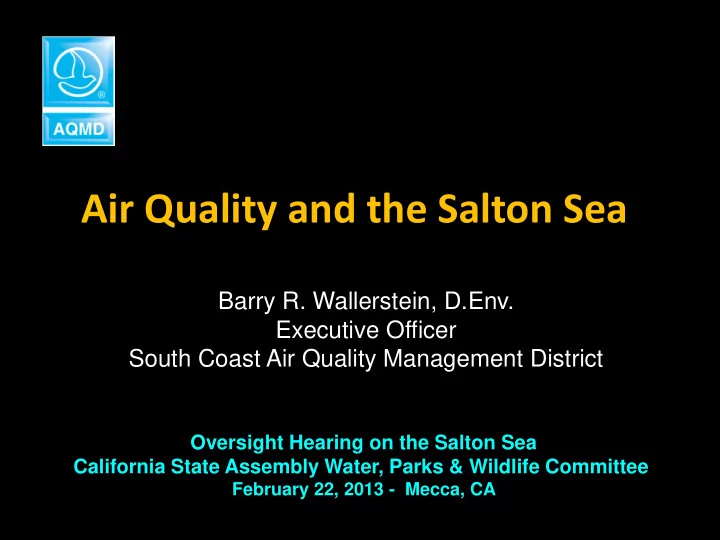

Air Quality and the Salton Sea Barry R. Wallerstein, D.Env. Executive Officer South Coast Air Quality Management District Oversight Hearing on the Salton Sea California State Assembly Water, Parks & Wildlife Committee February 22, 2013 - Mecca, CA
South Coast Basin Population …….. 17 million (about half of State’s population) Status …………….. Biggest air quality challenges in the nation
Potential Salton Sea PM Emissions • Fugitive Dust • PM10 and, to a lesser extent, PM2.5 • Receding shoreline may expose more emissive playa • Possible toxic components in dust • Hydrogen Sulfide • September, 2012 event experienced throughout Southern California • Local events may be more frequent • Secondary emissions from mitigation strategies • Construction – construction equipment, worker trips, etc. • Operation – pumps, IC engines, etc.
Fugitive Dust – Exposed Playa and Saltation Owens Lake Dust Storm Must identify and implement early mitigation strategies to avoid another Owens Lake situation
Owens Lake Dust Storm
Over 250 odor complaints received by AQMD September 8 -12, 2012 Odor descriptions (in descending order) Sulfur Rotten eggs Animal/human waste material Trash/garbage/landfill or natural gas/composting Foul/rotten Greasy/rancid/putrid /dead animal Pungent/acrid/ chemical/burnt
Sulfur Measurements H 2 S Location (ppb) Mecca South 149 Mecca West 109 Sea West 53 (West of Salton Sea) Desert Shores 42 (West of Salton Sea) Thermal 33 Indio 40 Riverside 11 Redlands 13 Cherry Valley 14 Beaumont Less than 2
Recommended Actions to Address Air Quality impacts of the Salton Sea • Fugitive Dust • Study potential for greater emissions • Identify and implement effective dust control strategies • Continue PM monitoring • Analyze dust for toxic components • Hydrogen Sulfide • Deploy monitors for real-time, rapid detection (underway) • Inform affected communities of source and risk • Control emissions from mitigation strategies • Zero or very low emission equipment
Recommend
More recommend